
Here I am, wearing one of the facemasks Jackie made, ready to go to the grocery store, or the mail room, or the laundry, or whatever.


Here I am, wearing one of the facemasks Jackie made, ready to go to the grocery store, or the mail room, or the laundry, or whatever.
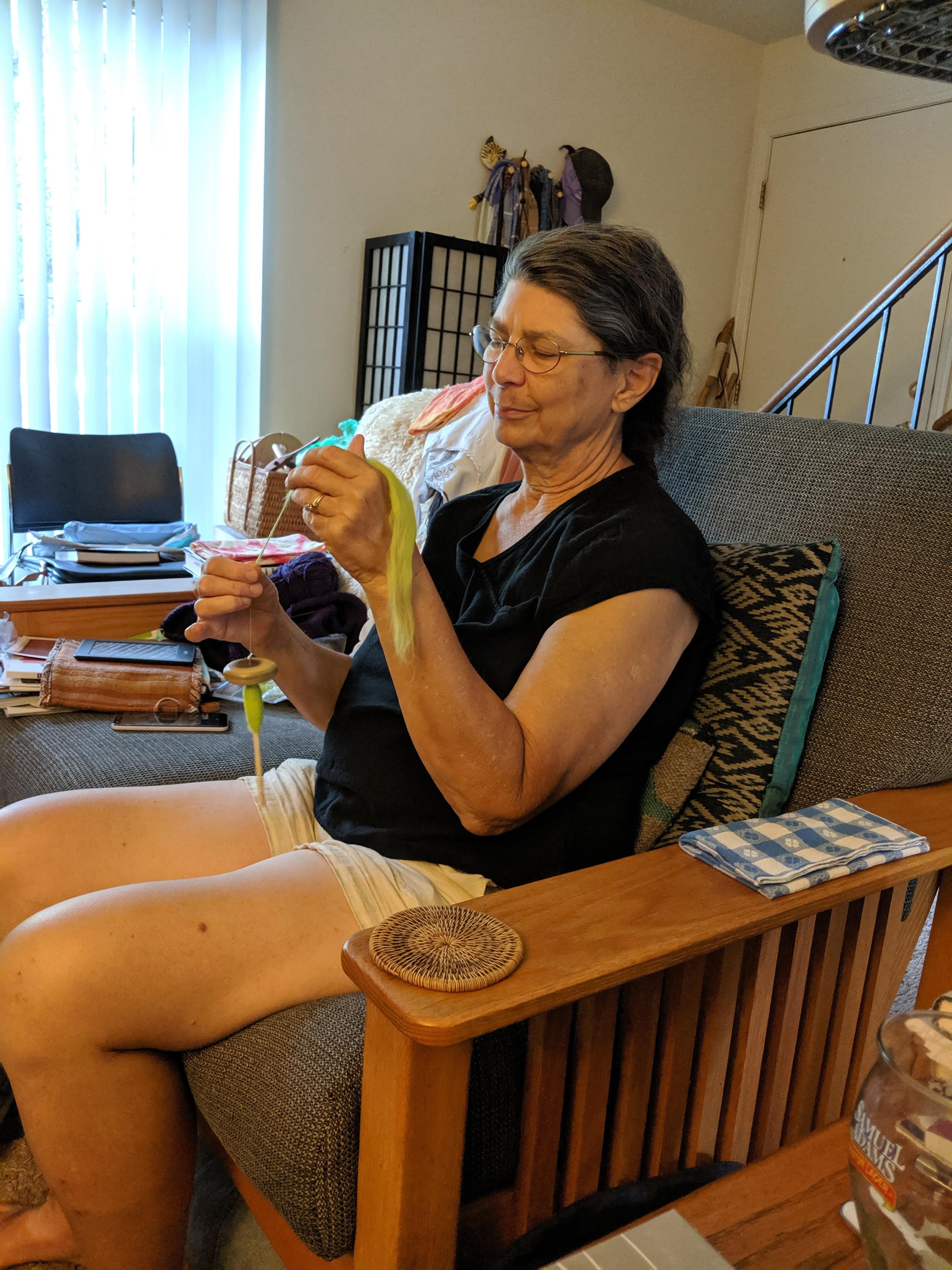
Spindle spinning. As @jackieLbrewer does.
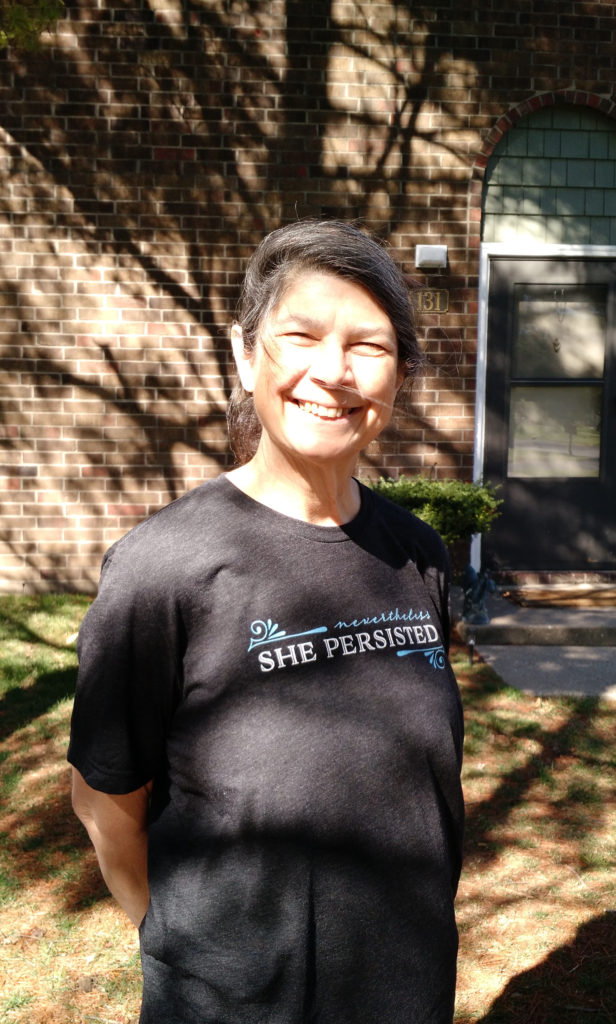 I bought Jackie a “Nevertheless, She Persisted” t-shirt designed by Jenn Reese.
I bought Jackie a “Nevertheless, She Persisted” t-shirt designed by Jenn Reese.
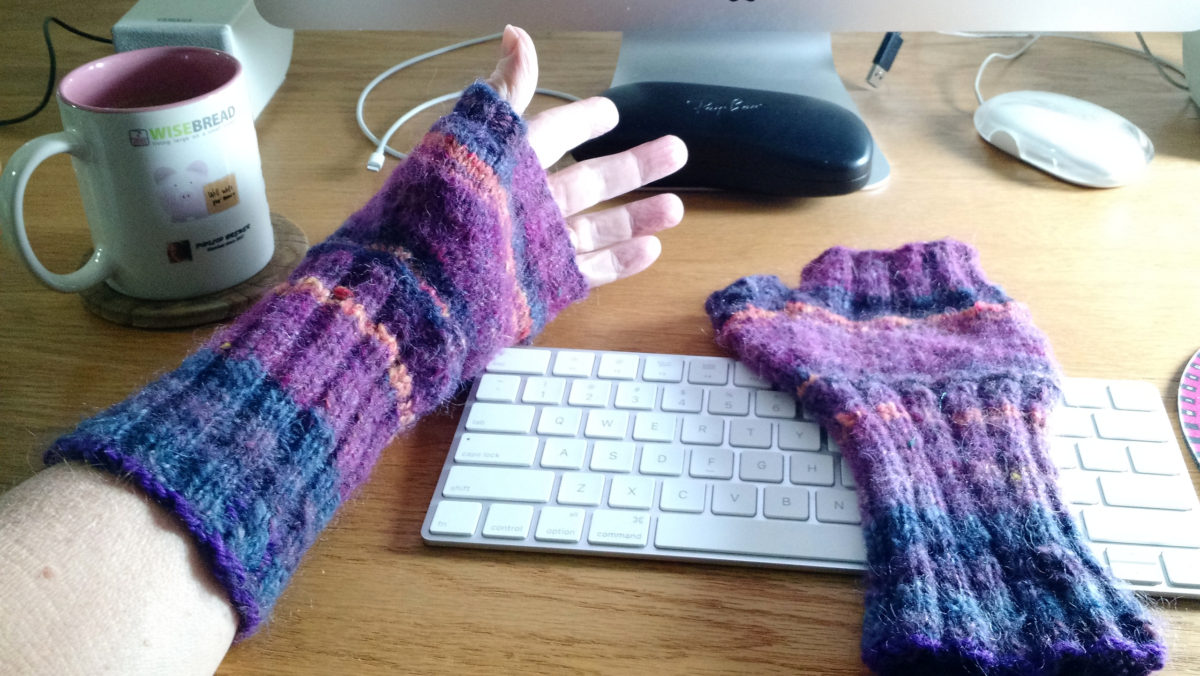
For days when it’s chilly, and yet I want to wear short sleeves, I have purple, blue and orange fingerless gauntlets.
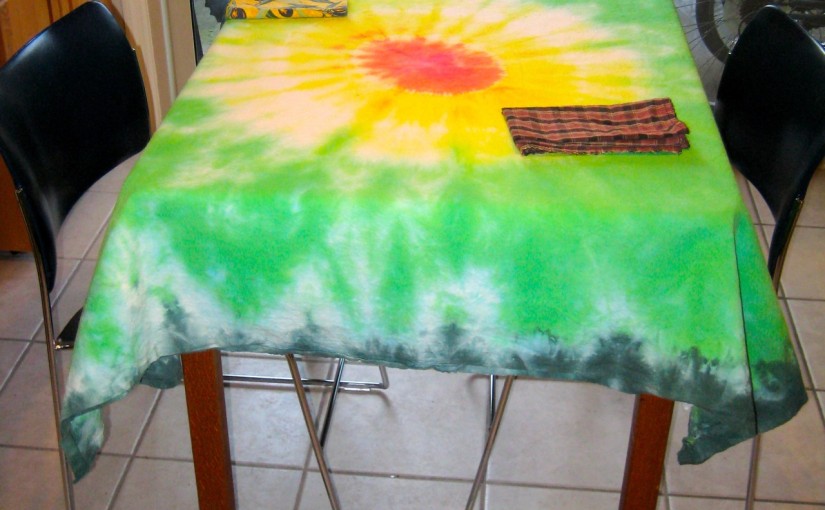
For various reasons, having to do with trivialities like the layout of our old apartment, Jackie and I had gotten into the habit of dining in the living room, often in front of the TV.
At each of the places we’ve lived since then, the layout was more conducive to dining at the table. Our summer place had a kitchen table in the kitchen, and we took nearly all of our meals there. In our winter palace, we put our dining table in the area of the living room that was obviously intended to be the dining area—closest to the kitchen, with a lamp over the spot for the table—and continued to eat at the table (even though much of the space was occupied by boxes).
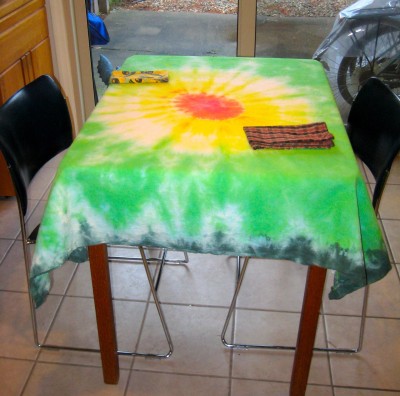 Here at Winfield Village, we have very nearly a full-fledged dining room, complete with a sliding glass door to the patio.
Here at Winfield Village, we have very nearly a full-fledged dining room, complete with a sliding glass door to the patio.
Although we’ve pressed a good bit of it into service as a pantry, there’s plenty of room for our little dining table, and we’ve continued to eat at the table.
Our old tablecloths had held up pretty well because they got little use, but now that we were using them all the time, Jackie wanted some new ones. She made one from a lovely piece of batik cloth that I’d brought home from a business trip to Singapore, which I declared probably the best tablecloth in the western hemisphere—until Jackie took some heavy muslin (that we’d previously used as a dropcloth to protect furniture against the depredations of the cat at our sublet), cut it to size, and dyed it some lovely spring colors.
After years of lazy, uncouth behavior, we are feeling very civilized.

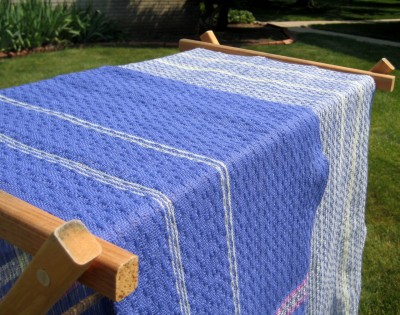 I did a photo-shoot for Jackie this morning, taking some pictures of her new fabric fresh off the loom.
I did a photo-shoot for Jackie this morning, taking some pictures of her new fabric fresh off the loom.
I rather liked this picture, which I think captures the texture of the fabric rather nicely. (Click the photo for a larger image.)
As I type this, she’s preparing to wind a warp for another piece of fabric to go with this one.
As I understand it, she’s making three difference pieces of fabric with three different weave structures, but all three made out of the same cotton yarn. Then she’s planning to use the fabric to make a blouse.
I expect Jackie will be posting on her new fabric shortly, with additional photos. So if you’re interested, keep an eye on her blog.
Jackie and I went to the Forest Glen Preserve, a nature preserve in eastern Illinois, over near the Indiana border.
We scouted the campgrounds, because the local Esperanto group is planning to some tendumado. We found two, although there’s at least one more.
One is a pretty ordinary Midwestern campground with a mixture of tents and RVs. It was pretty full, but only as crowded as you’d expect on Saturday morning of Memorial Day weekend. It had showers and flush toilets, firewood on sale, etc.
Near that one (but far enough away that noise wouldn’t be a problem) was the “tent campground.” It was different in that it didn’t have parking spaces for the campsites. There was an area just a few yards away where you could leave your car for up to 20 minutes to unload, and then you were supposed to move it to a parking area that was still really quite close—I’ve carried my luggage further in a hotel. Still, it seemed to be enough to discourage campers. Even Memorial Day weekend, there was nobody there—sixteen vacant campsites. (It did lack flush toilets. Also, the recent rain had left some of the campsites under water, although the dry sites were also vacant.)
Once we’d scouted the campgrounds, we went for a hike. We picked the Big Woods trail, which a posted list had described as the most rugged of the preserve’s trails. We took that with a grain of salt. Here in the flatland, pretty much any change in elevation seems to qualify a trail as rugged, but it was somewhat rugged. The train went down twice into ravines, then back up again, and ended at an observation tower at what I assume is the high point of the preserve.
We saw plenty of neat stuff—sugar maples and tulip trees, white oak, sassafras, ferns, various kinds of mushrooms. (I saw what might be the tallest sassafras tree I’ve ever seen. It was huge. I usually think of sassafras as being scrubby little things.)
The trail was muddy, but only very muddy in a few places (plus, of course, the places where it crossed running water). We ran into three very wet, dirty guys with tools who said they’d been doing trail maintenance.
The trail was only a little more than 1 mile, but out-and-back so we got in maybe 2 ¼ miles of hiking.
We left it at just that much hiking, because we still needed to go to the Viking Reenactment, which was the reason that we were visiting Forest Glen this weekend in particular.
Two of the reenactors seemed to focus on fiber crafts. One is a member of the spinners and weavers guild, and was using some of Jackie’s handspun yarn to demonstrate weaving with a warp-weighted loom. We had a fun chat.
The other fiber-crafty person told us about her theory of mud-colored peasants. Many reenactors, she said, end up with clothing in colors of sheep, because dyeing fabric is another whole skill that you need to learn—and making your own natural dyes is two or three more skills (growing or gathering dye plants, and learning how to prepare them for dye use). However, in her experience meeting actual modern-day poor peasants, even the really poor ones go to considerable effort to not be the color of mud. Hence, she proposed, actual Viking-era villagers probably wore clothing that was as brightly colored as possible, within the limits of the natural dyes that were available to them. (They had several sources of yellow, yellowish green, red, and purplish red. Blue was available. A really good green was tricky, because you had to get a good yellow and then overdye with blue.)
Despite her theories, all the other reenactors seemed to be wearing clothing in natural colors.
What with scouting and hiking and viking, it was already lunch time. We had lunch at Gross’ Burgers, then headed home (pausing just a bit at a rest stop to let a severe thunderstorm pass).
A good outing.

We keep our apartment cool, in the interest of minimizing our contributions to both resource depletion and global warming. Plus, Jackie likes to wear her woollies, which isn’t practical in a warm apartment. The only real downside is that, in a cool apartment, my hands get cold when I write. To address that problem, Jackie offered to knit me some fingerless gloves. (Click any of the pictures for a larger version.)
My first pair of fingerless gloves were knitted to my precise specifications. It’s made of fairly course yarn, which I figured would be fine for my purposes, and it has the fingers truncated almost completely, which I figured would make it easier to type.
Unfortunately, even just the row or two of knitting that formed the finger holes turned out make them a little uncomfortable for typing.
Since those weren’t quite satisfactory, I came up with a new design—fingerless gloves that not only had no fingers, they didn’t even have finger holes.
Jackie made these most lovingly. She not only spun yarn by hand, she spun it by hand while attending a science fiction convention (WorldCon in Toronto). The main color was hand dyed as well (with brazilwood). The yarn is wonderfully soft and fine. I got to pick the colors, and I picked these colors so that I could call them Rosebud Wristlets.
My Rosebud Wristlets were a complete success, and they’ve been my main fingerless glove for seven years (they were a Christmas present in 2003).
I liked them so well, I got Jackie to make a second pair that we gave to Kelly Link.
Not having fingers at all was great for leaving my fingers free for typing, but had a downside: My hands stayed warm, but my fingers sometimes got cold. So, I asked for yet another pair of fingerless gloves, this pair with fingers, but made from yarn so fine that it wouldn’t force my fingers uncomfortably far apart.
So, Jackie knit me this pair of fingerless gloves. Each glove finger extends out to the last knuckle of my finger. They’re made from machine-spun “fingering weight” yarn (perhaps called that because it’s the right weight to use when knitting glove fingers).
They’re wonderful. They’re not more wonderful than my Rosebud Wristlets, but they do keep my fingers warmer. So far I’ve been alternating between them, depending on whether just my hands are cold, or my fingers too.
For a while I’d imagined that I might design the ultimate fingerless glove, but it turns out, as usual, that the best tool for the job really depends not only on the precise details of what you’re trying to do, but also the precise circumstances under which you’re trying to do it.
My lovely wife, textile artist Jackie Brewer, is now blogging at jackiebrewer.com. She starts with some musing about the importance of thinking about what you did get done in the past year before worrying about what you didn’t get done.
Of course, Jackie does her musing with pictures.